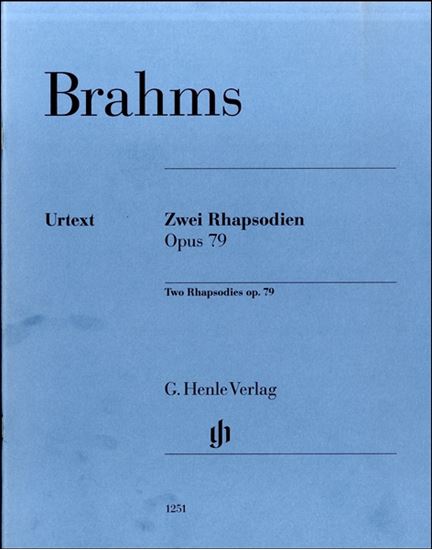Brahms, Johannes : 2 Rhapsodien Op.79
Work Overview
Publication Year:1880
First Publisher:Simrock
Instrumentation:Piano Solo
Genre:rhapsody
Total Playing Time:17 min 00 sec
Copyright:Public Domain
Commentary (1)
Author : Ito, Moeko
Last Updated: January 1, 2010
[Open]
Author : Ito, Moeko
This work was composed by Brahms in 1879, when he was 46 years old. In this year, Brahms composed works such as the Violin Sonata No. 1, Op. 78 (also known as the "Rain Song" due to the theme from his own song "Regenlied, Op. 59, No. 3," being used in the third movement). He also conducted the premiere of his only Violin Concerto, the Violin Concerto in D major, Op. 77, which he had composed the previous year, 1878. The violin solo at that premiere was performed by Joseph Joachim, who had provided much advice during the composition of this concerto. Furthermore, on March 11, he was awarded an honorary doctorate from the University of Breslau. (In response to this honorary degree, the Academic Festival Overture, Op. 80, was composed in 1880.)
From 1877 to 1879, Brahms spent his summers in Pörtschach, a town in Carinthia, southern Austria. Pörtschach is a resort town surrounded by the Alps and situated on the shores of Lake Wörthersee, the largest lake in Carinthia. It is a place of scenic beauty that continues to attract many people today. Brahms also favored the natural beauty of Pörtschach, writing to Clara Schumann (1819-1896), "There are so many melodies flying about [in Pörtschach] that one has to be careful not to step on them." This work was also begun there in the summer of 1879, during his third stay, and was premiered by Brahms himself the following year, 1880.
This work is dedicated to Elisabeth von Stockhausen (1847-1891), who is said to have been one of Brahms's closest confidantes. Elisabeth was a former student of Brahms and was herself active as a composer. Furthermore, Heinrich von Herzogenberg (1843-1900), a composer and conductor with whom Brahms had been close since around 1874, married Elisabeth, and this couple became among Brahms's greatest supporters. Elisabeth initially wished for the aforementioned Violin Sonata No. 1 to be dedicated to her, but Brahms instead composed and dedicated the Two Rhapsodies to her. This work is widely beloved among Brahms's piano compositions and is frequently performed in concerts.
It should be noted that Brahms did not continuously compose piano works until the composition of this work and the Eight Pieces, Op. 76, which were written around the same time. The progression of his piano compositions is as follows: In the 1850s (early period), he composed three piano sonatas (and some unnumbered studies remain). Subsequently, he worked on variations such as the Variations on a Theme by Paganini, Op. 35. From the 1860s to the 1870s, he composed works for piano duet, such as the Hungarian Dances, which are still frequently performed today. He then composed this work, but after this, Brahms did not touch piano works again until the period from 1892 to 1893. It is noteworthy that the works composed during this later period were small pieces, indicating that Brahms's piano compositions gradually transitioned from relatively large-scale works in his early period to smaller pieces.
Regarding the title "Rhapsody" for this work: Originally, it referred to the songs of ancient Greek bards, or rhapsodists. From the early 19th century, it began to be used as a title for instrumental music. The form is not fixed, and the instrumentation and performance style are also free. The title "Rhapsody" seems to be often given to fantasias with an epic, heroic, or patriotic character.
A letter from Brahms also remains, in which he asked Elisabeth during the dedication, "Do you know a better title than 'Rhapsody for Piano'?" However, in reality, this work was initially conceived as a Capriccio (meaning 'whim').
Rhapsody No. 1
Agitato, B minor, 2/2 time. This piece begins majestically and powerfully, featuring many leaps and a wide range from the low to high registers. There is an anecdote that Brahms's friends, upon hearing it, called it 'the young Johannes soaring through the heavens,' indicating its intensely emotional character. In contrast, a smooth, monophonic theme played pianissimo also appears. In the middle section, where the intensity suddenly vanishes, the key shifts to B major, the parallel major. Here, quiet movements with fewer leaps are central, with the right hand carrying two long, sustained melodies against the left-hand accompaniment. It seems to conclude calmly, reaching the tonic chord of B major, but immediately after, it shifts to the B minor tonic chord with the third lowered by a semitone, and the opening theme returns fiercely. After building to a climax with a wild, surging momentum, it quietly moves towards its conclusion.
Rhapsody No. 2
Molto passionato, ma non troppo allegro, G minor, 4/4 time. This is a grand work, beginning with an impressive theme of octaves struck in the low register. In contrast, a dark, writhing triplet melody appears in the dominant key of D minor, and this musical idea is developed further in the ensuing middle section. Throughout this middle section, the triplet movement is continuous, even with modulations. As it gradually moves towards pianissimo, hinting at a quiet ending similar to the first rhapsody, the recapitulation of the opening suddenly begins. A distinctive feature is that the melody which initially appeared in the dominant key now appears in the tonic key, as it would in the recapitulation of a sonata form, indicating that elements of sonata form are quite well-preserved in this work.
Movements (2)
Molto passionato, ma non troppo allegro Op.79-2
Key: g-moll Total Performance Time: 7 min 00 sec
PTNA & Partner Channel Videos(6items)
Sheet MusicView More
Scores List (23)

KMP(ケイ・エム・ピー) ケイエムピー

(株)音楽之友社

(株)全音楽譜出版社

(株)音楽之友社

(株)ヤマハミュージックエンタテインメントホールディングス

(株)ドレミ楽譜出版社

ヘンレー

ヘンレー

ヘンレー

ヘンレー

ヘンレ社(ヤマハ)

Neil A. Kjos Music Company

Neil A. Kjos Music Company

Breitkopf & Hartel

Breitkopf & Hartel

Breitkopf & Hartel

Breitkopf & Hartel

(株)ヤマハミュージックエンタテインメントホールディングス













